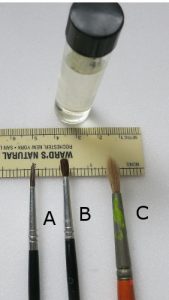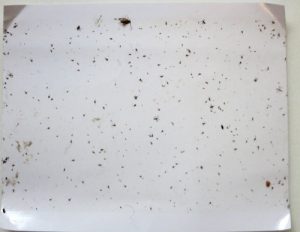Insect identification
A. How to catch an insect
1. How put insect in a zip lock bag
YOUTUBE VIDEO E-Zip Bug Collector http://www.youtube.com/watch?v=kGmdUsJiFa0
2. If insect is small or soft bodied, use a small bush with a pointed end. “B” is a good size. (See picture, left ) and alcohol (See Materials below).
3. Most insects are attracted to light.
4. Sticky traps or tape (see picture, right) are not the best way to collect for ID.

Place caption here. (Click Edit button)

Place caption here. (Click Edit button)
B. Why collect. It is easier for an expert to identify an insect if he can view it using a microscope.
C. You can take a picture but it must be clear and you should be able to see legs and antenna clearly. You will know the picture is good if you can see hairs on the arthropod. IF you only have a cell phone get a magnifying glass and take the picture holding it in front of the cell phone so it will magnify the bug.
D. Occasionally people call with what they think is a rea; insect but it is not. Therefore I have attached the following to hopefully help them.
Insect Problem with Unidentified Arthropod by Steven R Kutcher 1-9-2017
If you are having a problem with what you believe are arthropods and you have seen a doctor and a dermatologist and feel there is no other option but to contact an entomologist this may be of use to you.
In order to get an entomologist or the health department involved in your problem you have to find arthropods not symptoms or debris.
That means if you believe an arthropod is causing your problem you need to find 3 of the same type of bug with jointed legs or antenna or body parts.
You will need good magnification. Something that magnifies five or ten times. If you do not find anything then you will need to check your physiology and skin. Mites (bird mites or rat mites) are a common cause of problems but they can be seen with average eyesight. Try to find the source like a birds nest. IF you see something with legs use a very small bush (maybe 30 bristles) and get a small vile of rubbing alcohol. When you see a mite dip the brush in alcohol and touch it to the mite and then swirl the brush in the alcohol. That will release the mite and you should see it. Although you can try, I would not rely on pest control for finding insect problems it is up to you. Go on the internet and read about mite life cycles and how long they live without food.
If you do not find anything and you run the medical rout including a dermatologist then a good councilor or psychologist can help with dealing with the issue of stress.
There are other conditions that will manifest themselves as apparent insect bites
1. Medications. 2. Allergies. 3. A physiological condition. 4. Stress. 5. The environment 6. Products
You might find these links helpful
Invisible Itches: Insect and Non-Insect Causes
https://entomology.ca.uky.edu/ent58
Bird mites (two sources)
http://medent.usyd.edu.au/fact/birdmite.html
http://www.feelslikebugbites.com/Causes.html
If you think it’s a mite I can refer you to someone who will id the mite for a charge if you need to go that route but just knowing it’s a mite and knowing they cannot live more than 40 days without feeding. This means they should go away in 4-6 weeks. They cannot reproduce without feeding.
Materials you will need: 1. A small vial or container half filled with rubbing alcohol. 2. A small paint bush with 20-30 bristles. Like a small water color bush. 3. A magnifying glass or loop between 5x or 10 x magnification. 4. You might try a sticky trap. (Note* sticky traps collect all kinds of debris may people confuse with arthropods and spending time going through the debris and particles can be very unproductive) YOU have to be able to decide what an arthropod is and what is not. Remember IT MUST HAVE LEGS and or SEGMENTATION.
Taking a picture: If you only have a cell phone there are attachments to magnified views or get a good magnifying glass and use your cell phone and magnifying glass together. Must see legs and segmentation. You should also see tiny hairs to have a good id. IF the picture appears blurry I will probably identify it as blurry.
